The loaded water trend is helping young people increase their daily water intake by transforming plain H2O into a flavorful, nutrient-enhanced beverage. This viral TikTok phenomenon involves adding ingredients like fresh fruit, coconut water, electrolyte powders, and herbs to create drinks that claim to boost energy and reduce sugar cravings.
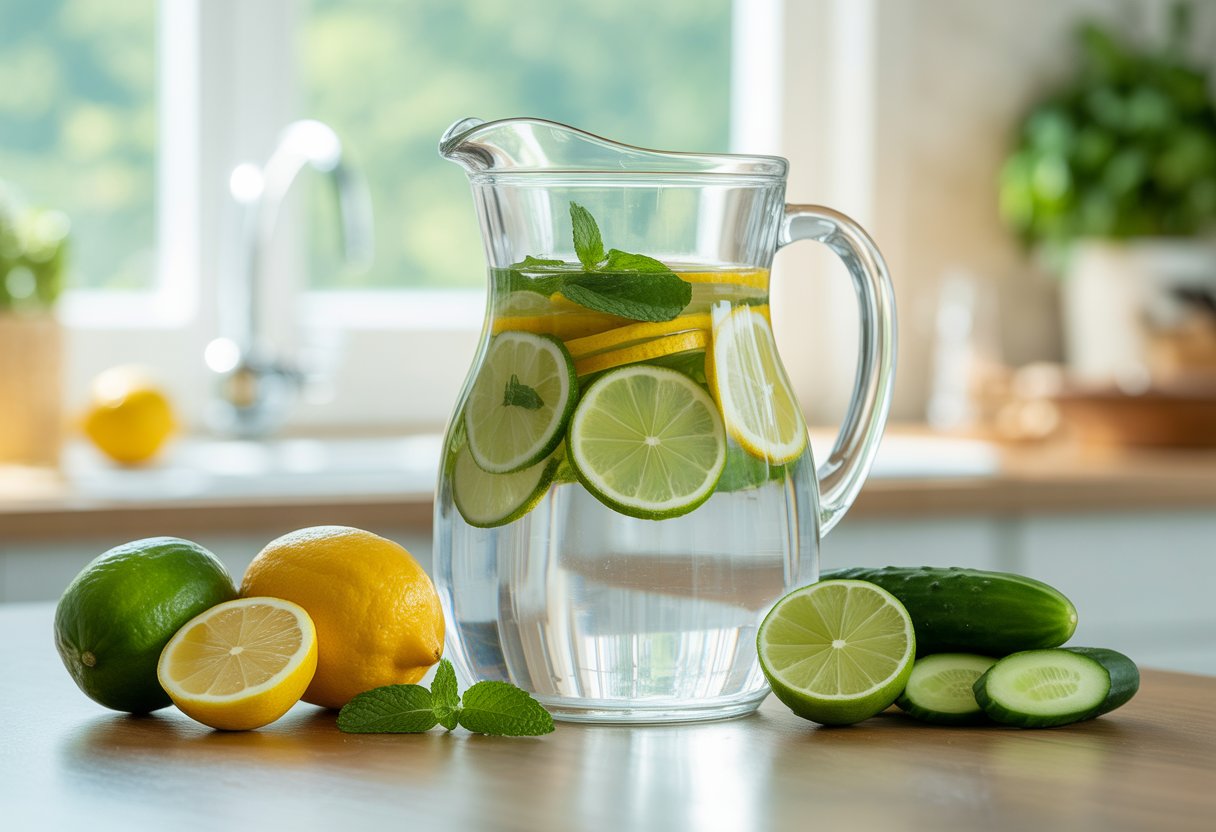
Making loaded water requires just filtered water, fresh ingredients like citrus fruits or watermelon, and 2-4 hours of steeping time in the refrigerator. The process is simple and cost-effective compared to store-bought alternatives, allowing people to customize flavors while staying hydrated.
Many Americans struggle to drink enough water daily, and loaded water offers flavor with fewer calories and less sugar than traditional sodas. Understanding the proper techniques and ingredient combinations helps maximize both taste and potential health benefits while avoiding common preparation mistakes.
Key Takeaways
- Loaded water combines plain or sparkling water with natural ingredients like fruit, herbs, and electrolytes to create flavorful hydration alternatives
- The preparation process involves steeping fresh ingredients in water for 2-4 hours and consuming within 2-3 days for optimal safety and taste
- While loaded water can encourage better hydration habits, most people can meet electrolyte needs through a balanced diet without commercial supplements
What Is Loaded Water?
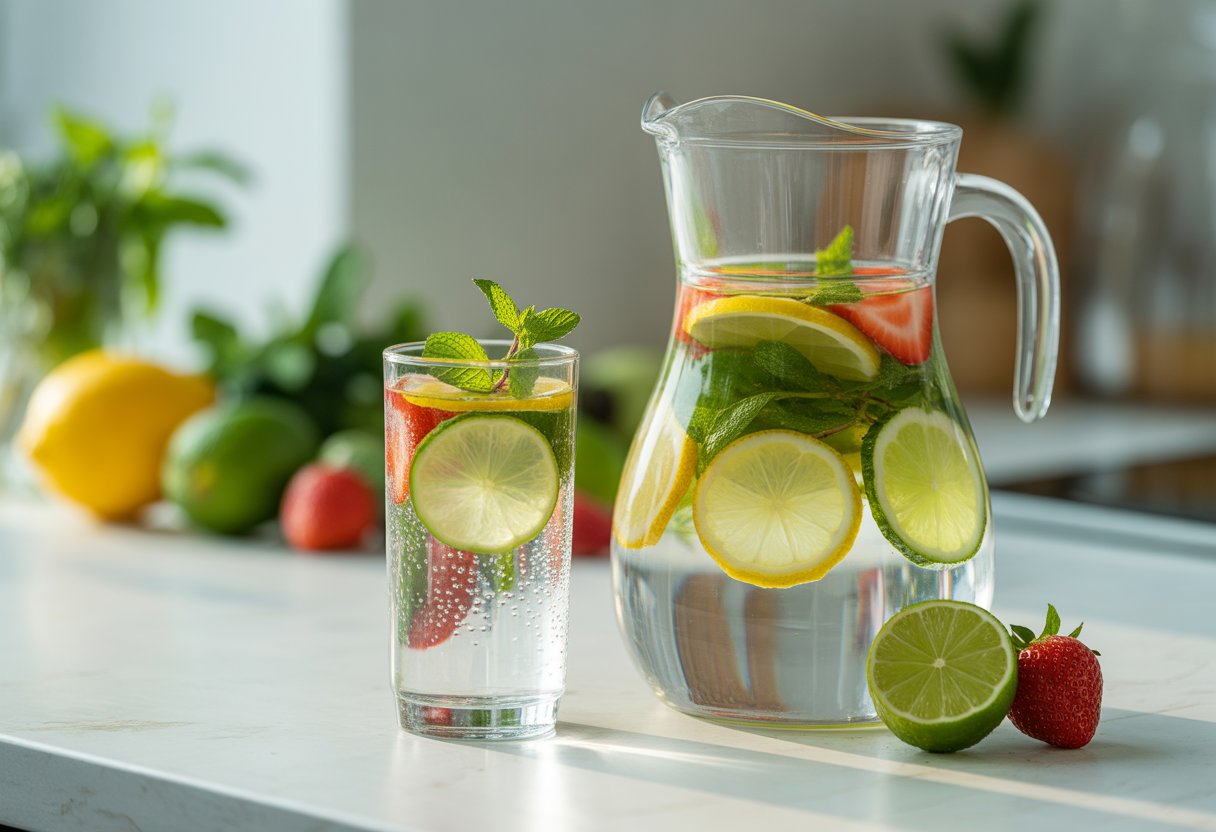
Loaded water combines plain or sparkling water with specific ingredients like electrolytes, fruits, and prebiotics to create a functional beverage. This trend differs from traditional infused water by focusing on targeted health benefits rather than just flavor enhancement.
Definition and Origins
Loaded water is gaining popularity as a flavorful alternative to plain water that aims to boost hydration and reduce sugar cravings. The trend emerged on social media platforms, particularly TikTok, where users share colorful recipes and health claims.
Unlike regular water, loaded water contains added ingredients designed to provide specific benefits. These additions can include electrolyte powders, fresh fruit slices, coconut water, or prebiotic supplements.
The concept focuses on making hydration more appealing while delivering functional benefits. TikTok users showcase loaded water recipes featuring everything from colorful fruit combinations to fizzy prebiotic sodas.
Advocates claim this approach helps people who struggle with drinking enough plain water throughout the day. The visual appeal and enhanced taste encourage better hydration habits.
Loaded Water vs Infused Water
Both loaded and infused water serve as refreshing alternatives for people who find plain water boring. However, these beverages have distinct differences in purpose and preparation.
Infused water focuses primarily on flavor enhancement through natural ingredients like cucumber, lemon, or mint. It typically contains minimal calories and aims to make water more palatable without adding functional ingredients.
Loaded water goes beyond flavor to include ingredients with specific health benefits. It may contain electrolyte powders, prebiotic supplements, or coconut water for targeted effects like energy support or gut health.
| Feature | Infused Water | Loaded Water |
|---|---|---|
| Primary Purpose | Flavor enhancement | Functional benefits |
| Common Ingredients | Fruits, herbs, vegetables | Electrolytes, prebiotics, coconut water |
| Calorie Content | Very low | Variable |
| Health Claims | Minimal | Energy, hydration, gut health |
Popular Loaded Water Ingredients
Coconut water adds natural sweetness and potassium to loaded water recipes. This ingredient may benefit people who exercise for longer periods or in hot weather conditions.
Electrolyte powders help replenish sodium, potassium, and magnesium lost during physical activity. These minerals support proper fluid balance and nerve-muscle function.
Fresh fruit slices provide natural flavor along with small amounts of micronutrients and antioxidants. Popular choices include citrus fruits, berries, and tropical options.
Prebiotic supplements like inulin or chicory root fiber may support gut health. A healthy digestive system can improve nutrient absorption and maintain steady energy levels.
Sparkling water serves as an alternative base for people who prefer carbonated beverages. It provides the same hydration benefits as regular water with added fizz.
Some recipes incorporate diluted fruit juices or natural syrups for extra flavor. However, these additions can increase sugar and calorie content significantly.
Key Ingredients for Loaded Water
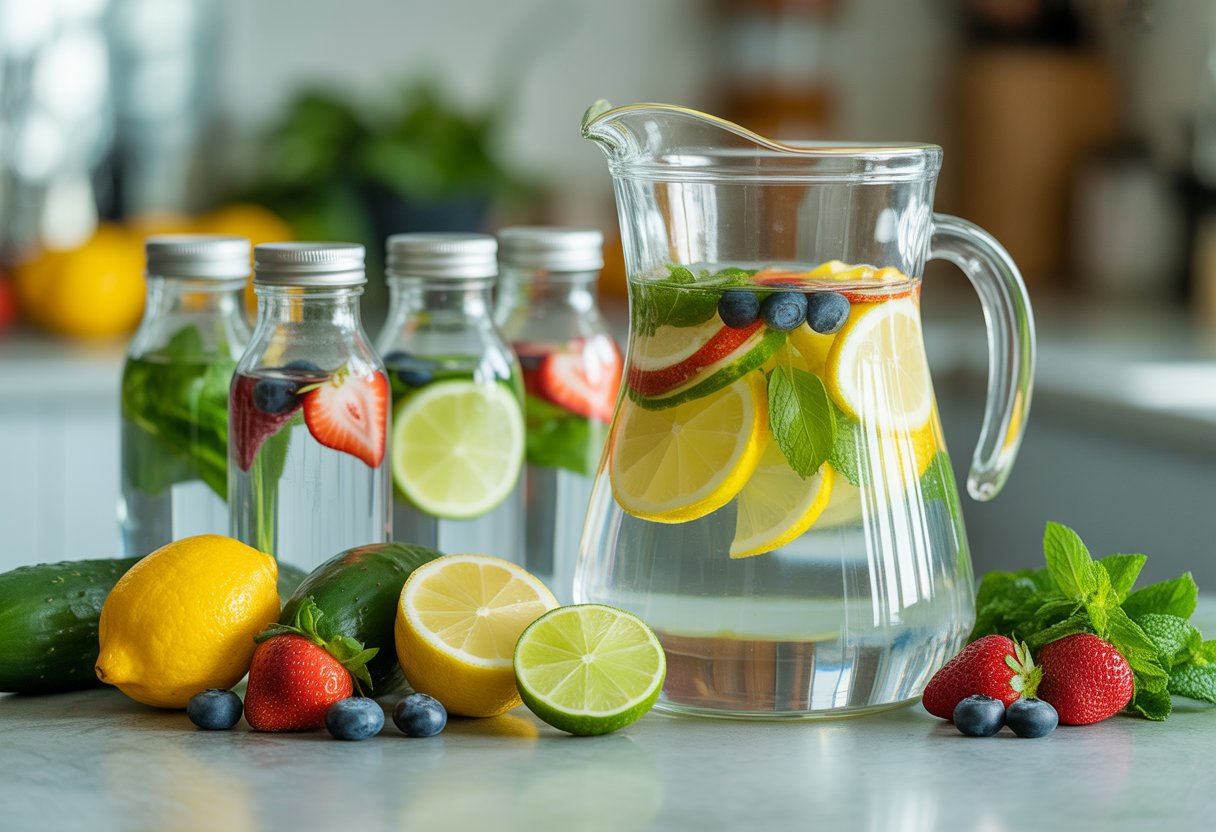
The right ingredients transform plain water into a nutritious drink that supports hydration and energy. Fresh fruits provide vitamins and natural flavor, while herbs add wellness benefits and aromatic appeal.
Fresh Fruits and Citrus Fruits
Fresh fruit forms the foundation of most loaded water recipes. Citrus fruits like lemons and oranges pack vitamin C and antioxidants that support immune function.
A lemon-cucumber combination provides potassium and magnesium for better hydration balance. Watermelon contains an amino acid that helps boost blood flow.
Popular fruit options include:
- Watermelon (hydrating and naturally sweet)
- Pineapple (contains digestive enzymes)
- Berries (rich in antioxidants)
- Cucumber (mild flavor with electrolytes)
Fresh fruits work better than frozen for texture. Cut fruit into chunks to release more flavor into the water. Remove fruit after 2-4 hours to prevent bitterness and bacterial growth.
Herbs for Flavor and Wellness
Herbs add natural flavor without calories or sugar. Mint creates a refreshing taste and aids digestion. Fresh herbs release more aromatic compounds when sliced or gently crushed.
Common herbs for loaded water include mint, basil, rosemary, and thyme. Each herb offers different health benefits and flavor profiles.
Mint pairs well with watermelon and citrus fruits. Basil complements berries and stone fruits. Fresh herbs should steep for 2-4 hours maximum to avoid overpowering the water.
Store herbs properly in the refrigerator. Wash all herbs thoroughly before adding them to water. Remove herb leaves after steeping to maintain fresh taste.
Electrolyte Sources and Powders
Coconut water serves as a natural electrolyte source rich in potassium. Electrolyte powders can help recovery after workouts by replacing minerals lost through sweat.
Most people who don’t exercise intensely can meet electrolyte needs through regular food. Fruits, vegetables, dairy, and nuts provide natural electrolytes.
Natural electrolyte sources:
- Coconut water (potassium-rich)
- Sea salt (small pinches)
- Lemon juice (natural minerals)
Pre-made electrolyte products can be high in sodium. Too much sodium without intense exercise may cause high blood pressure or kidney strain.
Natural Sweeteners and No Artificial Additives
No artificial additives keeps loaded water healthier than commercial drinks. Natural fruit sugars provide sweetness without processed ingredients. Loaded water offers flavor with fewer calories and less sugar when made thoughtfully.
Avoid artificial sweeteners, colors, and preservatives. Fresh ingredients provide natural sweetness and nutrients. Ripe fruits add more natural sugar than unripe options.
Natural sweetening methods:
- Extra ripe fruit
- Small amounts of raw honey
- Pure maple syrup (minimal amounts)
Natural ingredients cost less than commercial products. Homemade loaded water avoids unnecessary chemicals and additives found in store-bought versions.
Health Benefits of Loaded Water
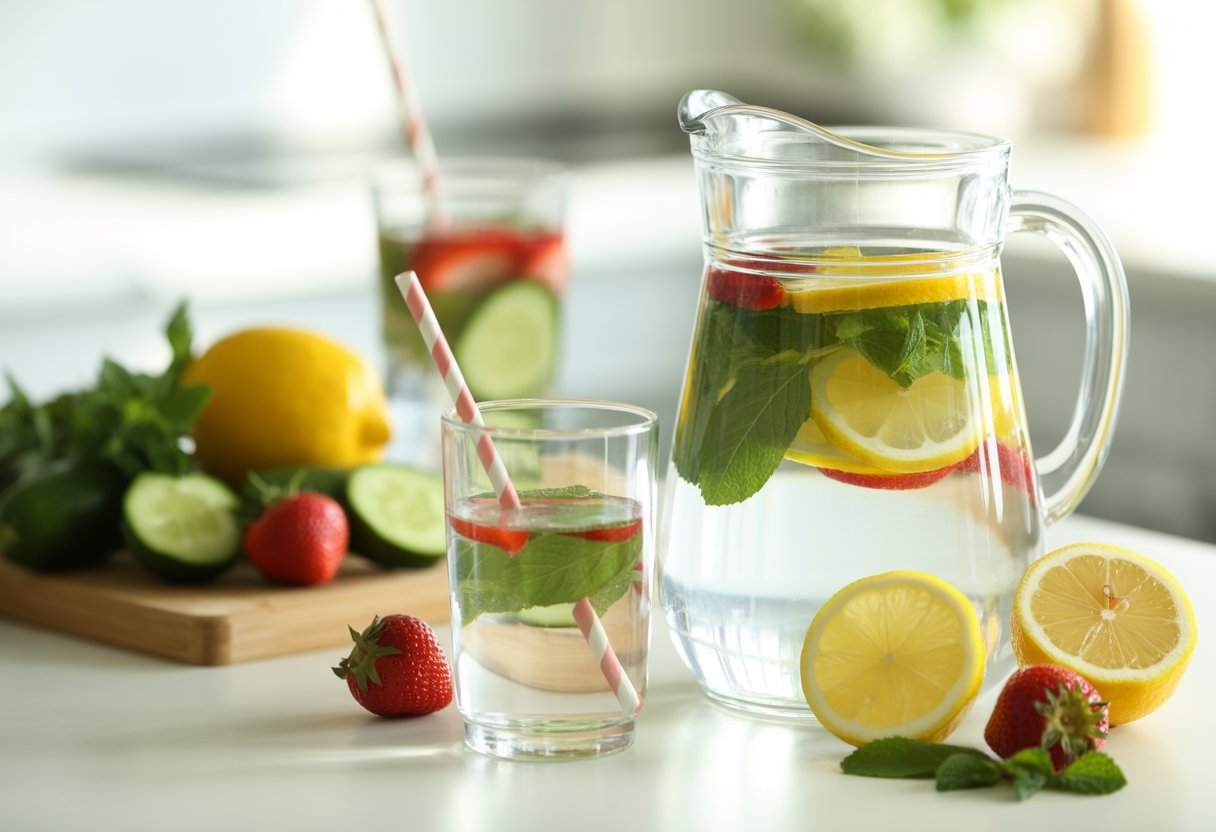
Adding specific ingredients to water can provide measurable health benefits beyond basic hydration. These enhanced beverages help replenish electrolytes, reduce sugar cravings, and deliver essential nutrients that plain water cannot offer.
Better Hydration and Electrolyte Balance
Loaded water with electrolyte powders helps the body maintain proper fluid balance more effectively than plain water alone. When people sweat during exercise or hot weather, they lose key minerals like sodium, potassium, and magnesium.
Electrolyte supplementation supports sustained energy during and after physical activity. These minerals help regulate nerve and muscle function, preventing the fatigue that comes from dehydration.
Key electrolytes in loaded water:
- Sodium – maintains fluid balance
- Potassium – supports muscle function
- Magnesium – helps energy production
Coconut water is a popular natural electrolyte source. It provides potassium and natural sweetness without artificial additives.
People who exercise regularly or work in hot conditions benefit most from electrolyte-enhanced water. Those with kidney disease or high blood pressure should consult healthcare providers before adding extra electrolytes.
Curbing Sugar Cravings and Fatigue
Proper hydration and stable blood sugar levels work together to reduce sugar cravings throughout the day. When the body lacks fluids or electrolytes, energy dips occur that trigger cravings for quick sugar fixes.
Loaded water helps maintain steady energy levels by supporting better blood sugar regulation. Electrolytes help cells absorb glucose more efficiently, preventing energy crashes.
Dehydration often disguises itself as hunger or sugar cravings. Many people reach for sugary snacks when they actually need fluids.
Adding natural fruit slices provides vitamins and fiber without the sugar spike from processed drinks. This satisfies sweet cravings while maintaining hydration goals.
Supporting Weight Loss and Metabolism
Loaded water can support weight management by replacing high-calorie beverages and improving metabolic function. Proper hydration helps the body burn calories more efficiently and process nutrients effectively.
Better hydration practices through loaded water can reduce overall calorie intake when it replaces sugary drinks. Each can of soda contains about 150 calories that loaded water eliminates.
Electrolyte balance affects how efficiently cells use energy. When minerals are depleted, metabolism slows down as the body conserves resources.
Metabolism benefits:
- Improved nutrient absorption
- Better cellular energy production
- Reduced water retention from sodium imbalances
Cold loaded water may slightly boost metabolism as the body works to warm the liquid to body temperature.
Antioxidant and Mineral Boost
Fresh fruits and certain additives in loaded water provide antioxidants that protect cells from damage. These compounds support overall health and may reduce inflammation in the body.
Berries, citrus fruits, and herbs like mint contain vitamins and plant compounds that plain water lacks. These nutrients support immune function and cellular repair processes.
Common antioxidant sources in loaded water:
- Lemon – vitamin C and citrus flavonoids
- Berries – anthocyanins and vitamin C
- Cucumber – silica and vitamin K
- Mint – rosmarinic acid
Prebiotic fibers like inulin support gut health when added to loaded water. A healthy digestive system better absorbs minerals and vitamins from food.
Some people experience digestive discomfort from prebiotics initially. Starting with small amounts helps the gut adjust gradually.
How to Make Loaded Water at Home
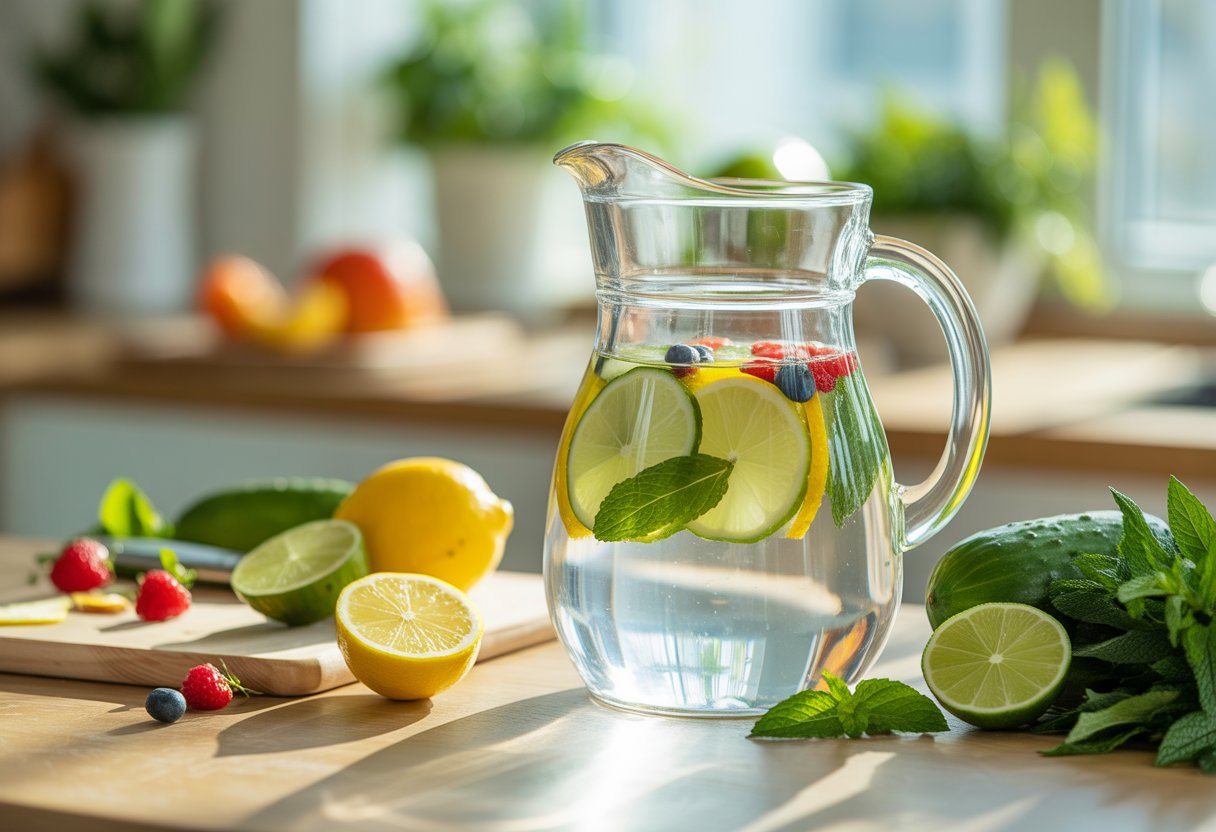
Making loaded water at home requires basic kitchen supplies and simple preparation techniques. The process involves selecting quality ingredients, proper steeping times, and safe storage methods to create flavorful, nutritious drinks.
Essential Supplies and Tools
The foundation for making loaded water starts with choosing the right base liquid. Plain water works perfectly as the neutral base, while sparkling water adds fizz and texture to the mixture.
A large glass pitcher serves as the main container for steeping ingredients. Glass containers work better than plastic because they don’t absorb flavors or odors from previous batches.
Basic Equipment Needed:
- Glass pitcher (32-64 oz capacity)
- Sharp knife for cutting fruits
- Cutting board
- Fine mesh strainer
- Measuring cups
- Airtight storage containers
Fresh fruits like lemon, cucumber, and citrus fruits require proper washing before use. A vegetable brush helps remove dirt and residue from fruit skins.
Herbs such as mint need gentle handling to prevent bruising. Fresh herbs release more flavor than dried versions when making infused drinks.
Step-by-Step Preparation Guide
Start with one liter of filtered water as the base. Registered dietitian Fiorella DiCarlo recommends using filtered or boiled, cooled water for the best results.
Wash all fresh fruits and herbs thoroughly under running water. Cut fruits into small pieces to release more flavor during steeping.
Preparation Steps:
- Fill pitcher with chosen water base
- Add 1-2 cups of coconut water if desired
- Cut fruits into ¼ inch slices or chunks
- Gently muddle herbs to release oils
- Combine all ingredients in pitcher
- Refrigerate for 2-4 hours minimum
Steeping for two to four hours in the fridge or overnight creates stronger flavor. Longer steeping times intensify taste but require careful monitoring.
Electrolyte powders can be added during the final mixing stage. Start with half the recommended serving size to avoid overpowering the natural fruit flavors.
Tips for Customizing Flavors
Different fruit combinations create unique taste profiles. Citrus fruits like lemon and orange provide vitamin C and bright acidity to the water.
Cucumber adds mild flavor and contains potassium for natural electrolyte balance. Watermelon brings sweetness and amino acids that support circulation.
Popular Flavor Combinations:
- Citrus Mint: Lemon, lime, orange slices with fresh mint
- Tropical Blend: Pineapple chunks with coconut water
- Garden Fresh: Cucumber, mint, and lime
- Berry Medley: Mixed berries with sparkling water base
Mint pairs well with most fruits and adds cooling properties. Use 3-4 fresh mint sprigs per liter of water for optimal flavor.
Frozen fruits work equally well and help keep the water cold. They release flavor more slowly than fresh fruits, requiring longer steeping times.
Coconut water naturally contains electrolytes and adds subtle sweetness. Mix coconut water with plain water in a 1:2 ratio to avoid overwhelming coconut taste.
Storage and Safety Best Practices
Proper storage prevents bacterial growth and maintains flavor quality. Store infused water in sealed containers in the refrigerator immediately after preparation.
Remove fruit pieces and herbs after the initial steeping period. Leaving ingredients in water too long can cause bitterness and encourage bacterial growth.
Safety Guidelines:
- Consume within 2-3 days of preparation
- Strain out all solid ingredients before storage
- Use clean utensils and containers
- Keep refrigerated at 40°F or below
- Discard if water develops off odors or colors
Glass containers with tight-fitting lids preserve freshness longer than plastic containers. Label containers with preparation dates to track freshness.
Citrus rinds can make water bitter if left too long. Remove lemon and orange peels after 4-6 hours of steeping for best results.
Fresh herbs lose potency quickly in water. Strain mint and other herbs within 8 hours to prevent overly strong or bitter flavors.
Popular Loaded Water Recipes
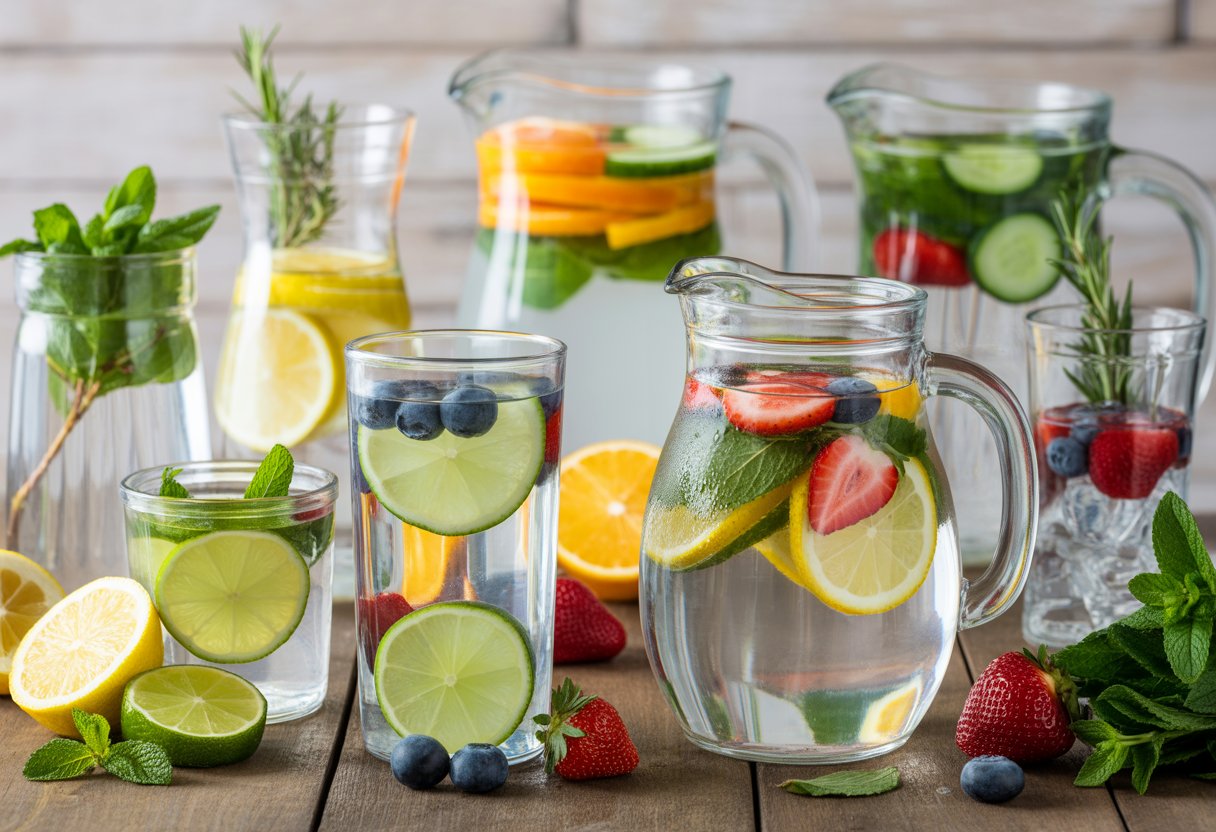
These three recipes combine hydrating ingredients with natural flavors to create refreshing drinks. Each blend offers different benefits while keeping calories low and sugar content minimal.
Classic Citrus and Mint Recipe
This recipe combines vitamin C-rich citrus fruits with refreshing mint for a energizing drink. The blend helps boost hydration while providing natural antioxidants.
Ingredients:
- 1 liter filtered water
- 1/4 sliced lemon
- 1/4 sliced lime
- 1/4 sliced orange
- 3-4 fresh mint sprigs
Instructions:
- Wash all citrus fruits and mint thoroughly
- Slice citrus fruits into thin rounds
- Gently bruise mint leaves to release oils
- Add ingredients to water and refrigerate 2-4 hours
The lemons and oranges provide vitamin C and natural electrolytes. Mint adds a cooling effect that many people find refreshing. This combination works well for daily hydration without added sugars.
Watermelon and Coconut Hydrator
This tropical blend combines electrolyte-rich coconut water with fresh watermelon. The recipe provides natural potassium and magnesium for better hydration.
Ingredients:
- 1 liter filtered water
- 2 cups coconut water
- 2 cups cubed seedless watermelon
- Optional: 2-3 mint leaves
Instructions:
- Cut watermelon into small cubes
- Mix water and coconut water in large pitcher
- Add watermelon pieces and mint if using
- Chill for 3-4 hours, then strain before drinking
Watermelon contains amino acids that support blood flow. The coconut water adds natural electrolytes without artificial additives. This recipe works especially well after exercise or on hot days.
Cucumber Lemon Electrolyte Blend
This mild-flavored recipe uses cucumber and citrus for gentle hydration support. The combination provides potassium and helps maintain electrolyte balance naturally.
Ingredients:
- 1 liter chilled water
- 1/4 large cucumber, sliced
- 1/4 lemon, sliced
- 1/4 lime, sliced
Instructions:
- Wash cucumber and citrus fruits completely
- Slice cucumber into thin rounds
- Cut lemon and lime into wheels
- Steep in refrigerator 2-4 hours maximum
The cucumber provides potassium and small amounts of magnesium. Fresh citrus adds vitamin C while keeping the flavor light and clean. This recipe appeals to people who prefer subtle tastes over strong fruit flavors.
Expert Opinions and Safety Considerations
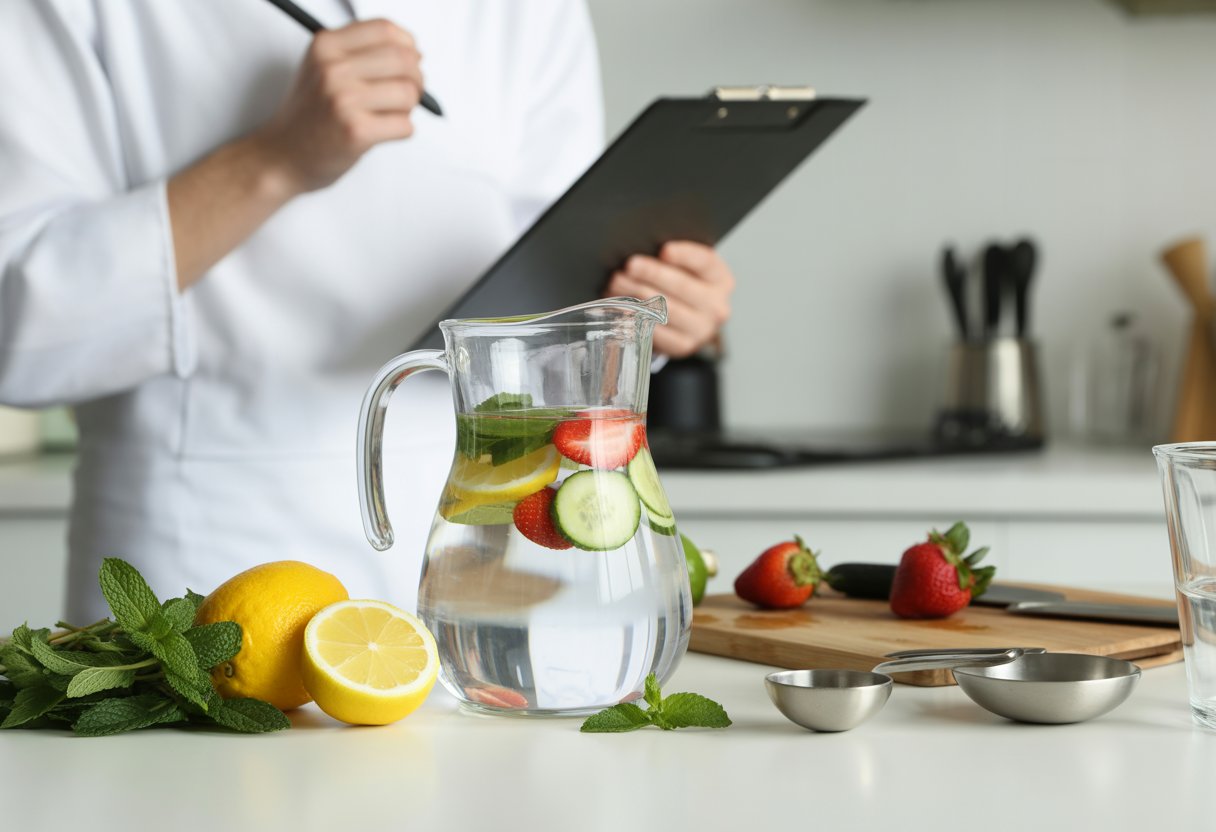
Registered dietitians emphasize moderation when adding ingredients to water, while quality sourcing and avoiding artificial additives remain key safety factors. Overuse of certain additives can lead to digestive issues or nutrient imbalances.
Insights from Registered Dietitians
Nutrition professionals generally support loaded water as a healthy alternative to sugary drinks. They recommend focusing on whole food ingredients rather than processed additives.
Most dietitians suggest limiting added ingredients to 2-3 per serving. This prevents overwhelming the digestive system and maintains palatability.
Key recommendations include:
- Start with small amounts of new ingredients
- Monitor individual tolerance levels
- Rotate different ingredient combinations
- Maintain plain water intake alongside loaded versions
Registered dietitians stress that loaded water should complement, not replace, a balanced diet. The nutrients from water additives provide minimal daily nutritional value compared to whole foods.
They also note that people with kidney conditions should consult healthcare providers before adding electrolyte-rich ingredients regularly.
Potential Downsides and Overuse
Excessive consumption of loaded water can cause digestive discomfort. High amounts of fiber-rich ingredients like chia seeds may lead to bloating or stomach upset.
Common overuse symptoms:
- Digestive cramping
- Frequent urination from excess electrolytes
- Blood sugar fluctuations from fruit additions
- Tooth enamel erosion from acidic ingredients
Certain combinations can interfere with medication absorption. Citrus fruits and herbs may affect how the body processes some prescriptions.
People often add too many ingredients at once, creating unpalatable mixtures. This leads to waste and discouragement from continuing healthy hydration habits.
Choosing Quality Ingredients
Natural ingredients without artificial additives provide the safest foundation for loaded water. Organic produce reduces exposure to pesticides and chemicals.
Quality indicators include:
- Bright, fresh appearance in fruits and vegetables
- Strong, pleasant aromas in herbs and spices
- No artificial colors or preservatives in purchased additives
- Proper storage and handling practices
The high levels of chemicals in fast-fashion products demonstrate why ingredient sourcing matters for all consumer products, including food additives.
Fresh ingredients typically offer better flavor and nutritional value than dried or processed alternatives. However, high-quality dried herbs and spices remain acceptable options when fresh varieties are unavailable.
Store all ingredients properly to prevent contamination. Wash fresh produce thoroughly before adding to water preparations.
Frequently Asked Questions
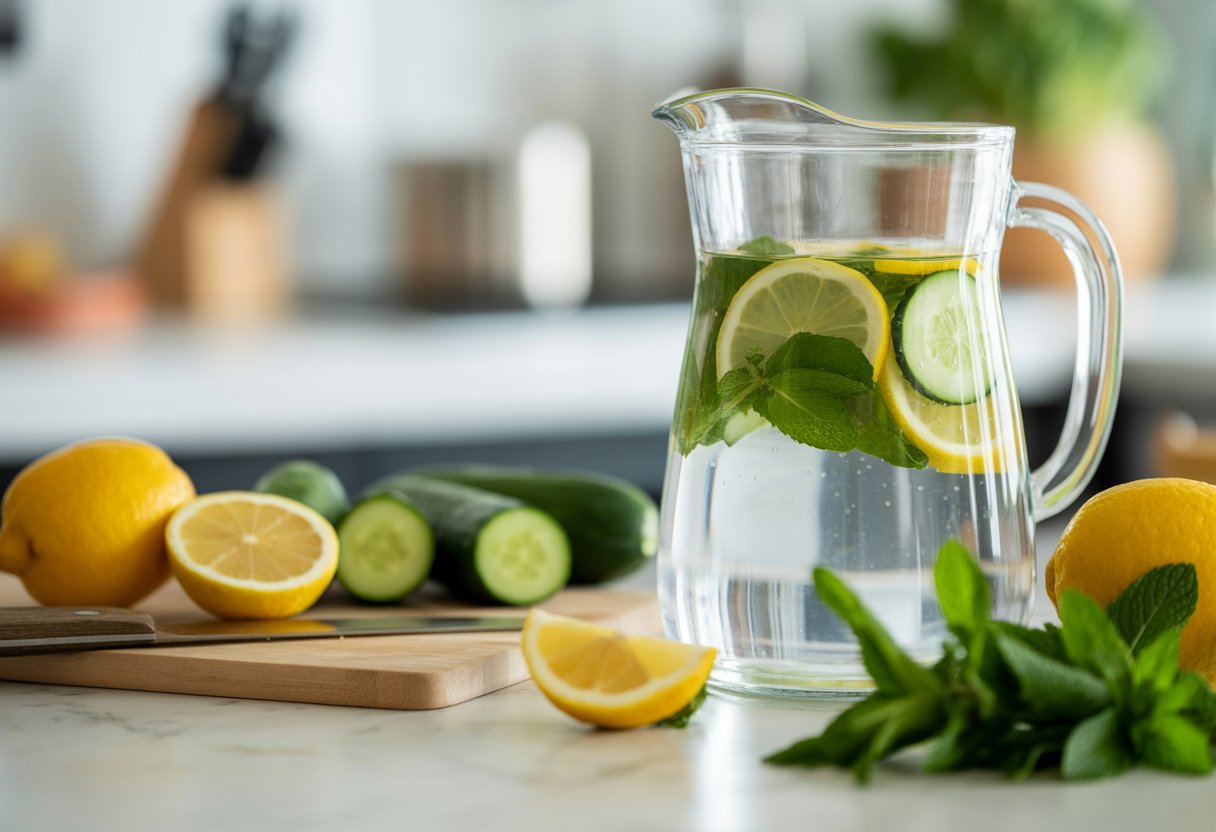
People often wonder about the best ingredients and methods for making loaded water. Common questions focus on preparation techniques, flavor combinations, and health benefits.
What ingredients are typically used in creating loaded water for health benefits?
Fresh fruits like lemons, limes, oranges, and berries provide vitamin C and antioxidants. Cucumber adds hydration and a refreshing taste. Mint leaves offer digestive benefits and natural flavor.
Herbs like basil, rosemary, and thyme contribute unique tastes and potential anti-inflammatory properties. Ginger adds digestive support and a spicy kick to water infusions.
Vegetables such as celery and bell peppers can enhance mineral content. Some people add chia seeds or electrolyte powders for extra nutrients.
Can you provide step-by-step instructions for preparing homemade infused water?
Start with clean, filtered water in a large pitcher or jar. Wash all fruits, vegetables, and herbs thoroughly before use.
Cut fruits into thin slices or small pieces to release more flavor. Muddle herbs gently with a wooden spoon to release oils without breaking them completely.
Add ingredients to water and refrigerate for 2-4 hours minimum. For stronger flavor, let the mixture sit overnight.
Strain the water before drinking if desired. The infused water stays fresh for 2-3 days in the refrigerator.
Which loaded water recipes are considered the best for enhancing hydration and wellness?
Lemon-cucumber-mint combinations provide electrolytes and support hydration. The cucumber adds silica and potassium while mint aids digestion.
Berry mixtures with strawberries, blueberries, and raspberries offer antioxidants. These combinations taste naturally sweet without added sugars.
Citrus blends using orange, lime, and grapefruit provide vitamin C and natural electrolytes. These recipes help maintain fluid balance in the body.
Watermelon-basil combinations deliver lycopene and natural sugars. The high water content in watermelon enhances the hydrating effects.
How can loaded water contribute to weight loss, and what recipes are recommended?
Flavored water helps people drink more fluids throughout the day. Increased water intake can boost metabolism and reduce hunger between meals.
Lemon-ginger combinations may support metabolism and digestion. The ginger adds thermogenic properties that could increase calorie burning slightly.
Cucumber-lime water contains very few calories while providing satisfying flavor. This combination helps replace higher-calorie beverages.
Green tea-based infusions with mint provide caffeine and antioxidants. These recipes can support energy levels during weight loss efforts.
What are some simple yet flavorful loaded water combinations for daily consumption?
Lemon-lime slices create a classic citrus blend that works well any time of day. This combination provides consistent flavor without being overwhelming.
Cucumber-mint offers a cooling, refreshing taste perfect for hot weather. The mild flavors make this suitable for people new to infused water.
Orange-cinnamon stick combinations provide warmth and natural sweetness. This pairing works especially well during cooler months.
Strawberry-basil creates an unexpected but pleasant flavor profile. The herb balances the fruit’s sweetness with earthy notes.
Are there any special tips or techniques to enhance the flavor of infused water recipes?
Freeze fruits in ice cube trays to create flavored ice that won’t dilute the water. This technique maintains taste strength as the ice melts slowly.
Use room temperature water initially to help ingredients release flavors faster. Then refrigerate the mixture after the first hour of infusion.
Muddle delicate herbs gently to avoid bitter flavors from over-crushing. Press just enough to release oils without breaking cell walls completely.
Add ingredients in stages for complex flavors. Start with citrus fruits, then add herbs after two hours of initial infusion time.